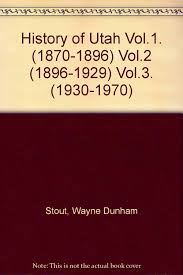Articles/Essays – Volume 03, No. 3
One Man’s Utah | Wayne Stout, History of Utah
The writing of history is fraught with difficulties because the historian has no direct access to the past. Through newspapers, diaries, journals, and public documents prior events may be glimpsed as shadows, but even then it is as though one saw through a glass darkly. Writing a history of Utah is in some respects uniquely difficult. The documents upon which that history must be based are overflowing with biases, ulterior motives, and inferior perceptions. Territorial officials in their reports of the “Utah situation” frequently either deliberately misinterpreted events in the Great Basin or mis judged its people. And the Mormons who recorded their feelings and reactions to these same events often misjudged the intent and motives of federal officials.
Wayne Stout’s book could hardly be ranked by any valid criteria as one of the better works covering events in Utah between 1870 and 1896. In this preface Stout accuses many historians of submitting “to a strict code that only facts should be recorded” (p. 1). Personal opinions were not to be ex pressed or elaboration or meaning attached to the facts. Contrary to such a view, Stout boldly proclaims, “The author refuses to be shackled by these re strictions . . . accordingly this history will be an editorialized commentary on the issues and events which vexed the people of Utah during this period” (p. 1). Every knowledgeable historian knows that history is not written in a vacuum, free from bias. The very “facts” that are gathered reflect the predilections of the author. Stout is preaching nothing new. But what he believes to be a new point of view causes him to overlook evidence that would nullify some of his conclusions. Had he “editorialized” after or even while he presented all of the evidence, he could perhaps be forgiven, or even applauded.
But his book reflects a less than thorough search for all the available facts. Furthermore, some of his statements are so exaggerated they hardly deserve serious attention. For example, how can a reviewer comment on such remarks as the one which appears in the preface charging that the “infamy of the segregation rulings reduced the federal judges to the level of barbarians, who like Judge Jeffreys, loved to be cruel”? Or this one: “The passage of the law [Edmunds-Tucker] stunned the people of Utah. The vicious act reduced Utah to the status of a Spain in the 13th century, with all the cruelties of the Spanish inquisition.”
The reader is struck by the tone of crisis that almost shouts from the book’s pages. Somehow Stout has made every day in Utah a day filled with anxiety. If Stout’s book is to be believed, fleeing from snooping, malicious federal agents, attempting to thwart a federal conspiracy, standing firm for conscience’s sake against the tyranny of United States law, and waging vigorous political campaigns were the daily diet of most Mormons. He says nothing about the drudgery of wresting a living from a reluctant soil in the hot desert sun, the biting cold of Utah winters, or the despair that accompanied drouth, insects, and hail. The monotony and cultural starvation of a life of washing, ironing, and cooking that plagued many Mormon women is never described. Nor does he talk about the Salt Lake Temple, the Tabernacle organ, the growth of church schools, the development of mining, the pastoral activity of the Protestant, Catholic, and Mormon churches, the growth of farming, or the rise of cities. He says nothing about the theater, the musicals, the polysophical society, or the gradual changes in some Church practices that developed during this period of time. Stout’s portrayal of constant crisis leaves the reader with a false picture of life in Utah.
Stout infers that all Mormons were “good guys” dressed in white, while all Gentiles, especially Judges McKean and Zane, Governors West, Murray, Woods, and Emery, and Presidents Grant, Harrison, and Cleveland were the “bad guys” clad in black. His use of descriptive adjectives is designed to make it abundantly clear that no Gentile ever acted from lofty motives or from humanitarian impulses and that every Mormon was above reproach. A more accurate or balanced account might have emerged had he read diaries, journals, public records, and monographs covering this period.
Stout makes an attempt to refute some of the more recent writers of Mormon history who have argued that Utah history must be understood as a great political struggle involving the “Kingdom of God.” Contending that polygamy was really the reason for the anti-Mormon campaign, he writes, “A second popular superstition adhered to by the non-Mormon world was the alleged existence of an all-powerful Council of Fifty which dictated the poli tical affairs of the territory. The so-called ‘Invisible government,’ it was further alleged, aimed ultimately to dominate all of America. These fabrications, too, have been repudiated” (pp. 1—2). Such a conclusion enabled Stout to write a book of over five hundred pages without even mentioning the Council of Fifty except in the preface. Yet he does not produce evidence that would repudiate the findings of Gustive O. Larson, James R. Clark, Hyrum Andrus, Juanita Brooks, and Klaus Hansen.
It is sad that so much effort and so many years of a person’s life have been devoted to a book that will be of little value to the serious student of history and will probably mislead the casual reader. There still remains a need for some competent historian to produce a major study that will be a real history of Utah.
History of Utah. By Wayne Stout. Salt Lake City, Utah: Wayne Stout, 1967. 553 pp., $10.00.


 Back to full Issue
Back to full Issue

